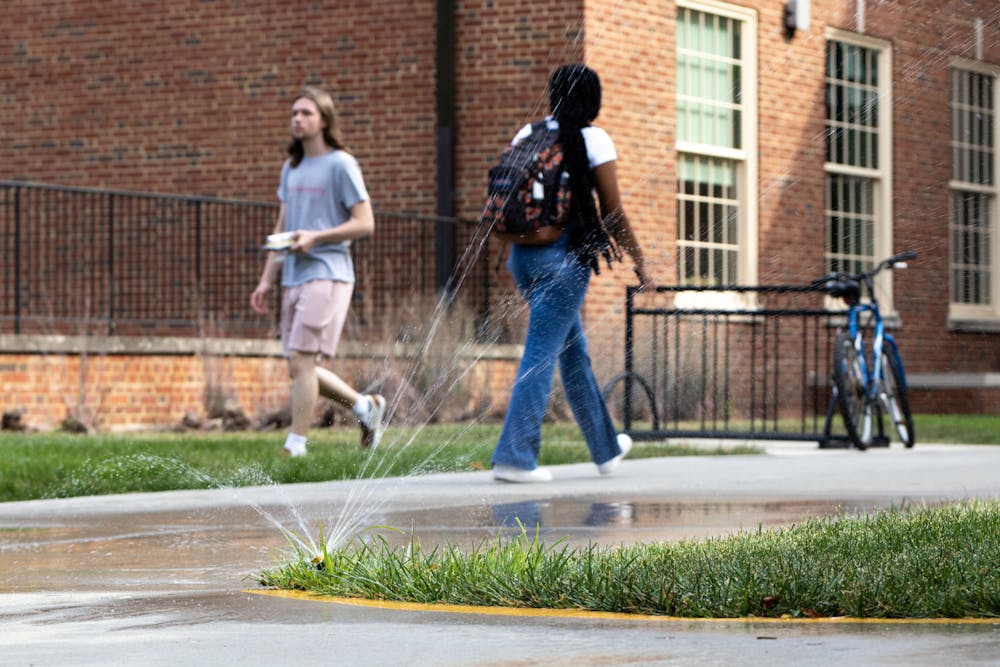If you’ve walked through Miami University’s campus early in the morning or late at night, chances are you’ve seen an unsuspecting student getting doused in water from the sprinkler system. Most of the Miami campus has witnessed the sprinkler system in action, working hard to keep our lawns and sidewalks watered.
Miami has roughly 2,500 acres of grounds, much of which consists of grass in between various walkways and buildings, and these acres need to be maintained through irrigation.
Cody Powell, the associate vice president of facilities planning and operations, said the upkeep of these spaces helps them “achieve a certain experience.”
On most of Miami’s promotional material, there is some variation of pictures of the well-manicured, healthy, green lawns that make up the campus. Without the sprinkler system during times of drought and especially dry summers, Miami’s campus would not look the same.
However, this also leads to some issues for the student body when these sprinklers end up watering the sidewalks.
Laura Zipes, a junior majoring in history and middle childhood education, frequently gets caught in the crossfire of Miami’s lawn maintenance on Central Quad.
“I think the grass looks great and Miami prides itself on its awesome landscape,” Zipes said. “But it is a little annoying to have to walk past and be drenched every time I go to my hall.”
The sprinkler system is divided into different sections that water different parts of the campus at different times. When the weather is dry, these zones go off three times a week, running from 20 to 30 minutes. When there is more rainfall, the irrigation typically runs for a maximum of 15 minutes.
The sprinklers are programmed to go off in the morning or in the evening when there’s less foot traffic, but many students still manage to get sprayed by them.

A student runs past a sprinkler to avoid being struck.
The area where Zipes lives is a section that goes off around 7 p.m., when many students are headed back from class or going to dinner. However, Powell said if the sprinklers were to be on in the middle of the day, there would be “more of an opportunity to get sprayed, which we want to avoid.”
The different section divisions also allow for some locations on campus to not be maintained at all, whereas others, like North Campus, need to be irrigated more frequently.
Enjoy what you're reading?
Signup for our newsletter
“The green space between the psychology and engineering buildings, there’s that parking garage underneath,” Powell said. “It’s hot and you only have so much grass and dirt. You have to irrigate that more frequently or it’ll kill [the grass].”
To some students like Gracie Grady, a sophomore majoring in political science and minoring in community leadership and education, this amount of water usage seems excessive.
“One time, I was driving through campus with my windows down and the inside of my car got a little sprinkled,” Grady said.
Grady is also a district 5 senator on the Associated Student Government (ASG) and said other students feel so strongly enough about the sprinklers that they’ve made formal complaints to ASG. ASG brought this complaint to the university, which cited the lack of rain as the cause.
“We [Miami University] have to have the sprinklers on because there hasn’t been enough rain,” Grady said, sharing Miami’s response.
Powell confirmed that Miami will often try to adjust how frequently they irrigate depending on the weather and rainfall.
“We have the ability to have an iPad and determine if a particular zone needs to be more or less and so they make adjustments to those schedules,” Powell said.
Miami doesn’t specifically calculate the cost of the sprinkler system, Powell said, because its budget is combined with the annual water budget overall.
The vast majority of the water comes from the local city water supply, but in some parts of the campus, the water is reused. On Western Campus, the rainwater as well as the condensation from the air conditioning units are collected in the large pond between Young and Hillcrest Hall and then reused for irrigation purposes.
Powell recognizes the different opinions about Miami and its water usage to maintain its green spaces but emphasizes its importance.
“We see a lot of students outside enjoying the environment, and we want to make sure that we have that right type of outdoor environment, and we want to do that in as sustainable and cost-effective [a] way as possible,” Powell said.
Grady’s advice to other students making their way through the sidewalks of Miami: “Do your best to stay dry. It’s not raining, but we still get drenched.”




